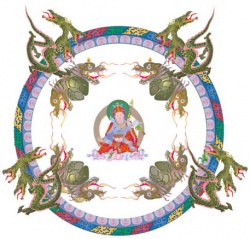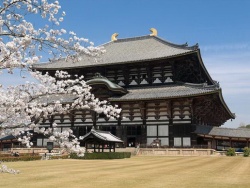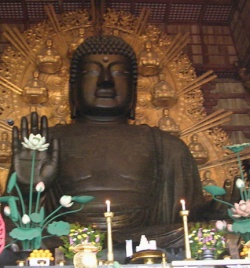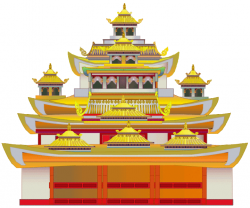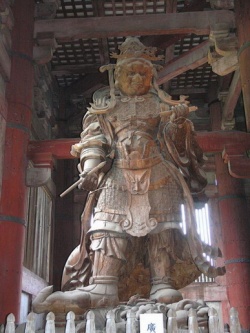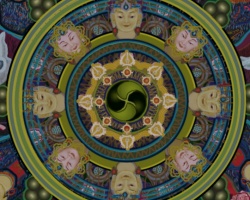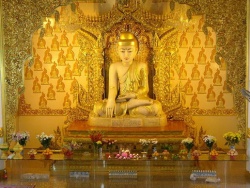Principle Of Attaining Buddhahood With The Present Body
KUKAI'S
SOKUSHIN-JOBUTSU-GI
Principle Of Attaining Buddhahood With The Present Body
translated by Hisao Inagaki
INTRODUCTION
Chinese esoteric Buddhism entered a new epoch in the eighth century when Shubhakarasimha (善無畏 Zenmui, 637-735) and Vajrabodhi (金剛智 Kongochi, 671-741) produced Chinese translations of the Mahavairocana Sutra and the Diamond Peak Sutra , respectively, thereby promulgating what is called "genuine esotericism" (純密 junmitsu) as distinguished from "mixed esotericism" ( 雑密 zomitsu). Furthermore, Amoghavajra (不空金剛 Fukukongo, 705-74), Vajrabodhi's disciple, actively engaged in the dissemination of the teaching while translating a large number of esoteric texts which he had brought from India. It was his disciple Hui-kuo (恵果 Keika, 746-805) who transmitted the teaching to Kukai when the latter visited China.
Kukai (774-835), popularly known by the name of Kobo Daishi, after returning to Japan, propagated the esoteric teaching in Kyoto and elsewhere while writing a number of works. Being a faithful follower of the esoteric tradition, he based his system of thought on the teachings of Indian and Chinese masters and attached especially great importance to the sutras of genuine esotericism and two treatises attributed to Nagarjuna, namely, Treatise on Bodhi-Mind (菩提心論 Bodaishinron) and Commentary on the Treatise on Mahayana (釋摩訶衍論 Shakumakaenron). He further developed and systematized the doctrine with his extensive knowledge and religious ingenuity. Thus, the system of the Shingon sect which he founded represents the apex of Buddhist esotericism.
Of all the works of Kukai, the following six considered the most important in the Shingon sect:
(1) Ben-kenmitsu-nikyo-ron (辯顯密二教論), 2 fascicles, T.T.No.2427, a treatise which compares exoteric and esoteric teaching and shows that the latter is superior because it was expounded by the Dharmakaya Buddha.
(2) Sokushin-jobutsu-gi (即身成佛義), 1 fascicle, T.T.No. 2428.
(3) Shoji-jisso-gi (聲字實相義), 1 fascicle, T.T.No. 2429, a treatise which establishes the doctrine that Mahavairocana's preaching of Dharma is heard through phenomenal existences.
(4) Unji-gi (吽字義), 1 fascicle, T.T.No. 2430, a discourse on the significance of the mystic letter "HUM", saying that it contains deep and boundless significance of the absolute truth and that one can attain the state of Mahavairocana by contemplating on it.
(5) Hizo-hoyaku (秘蔵寶鑰), 3 fascicles, T.T.No. 2426, a discourse on the ten stages of spiritual progress which correspond to the ten categories of Buddhist and non-Buddhist paths.
(6) Hannyashingyo-hiken (般若心經秘鍵), 1 fascicle, T.T.No. 2203, a commentary on the Prajnaparamita-hridaya Sutra.
These six works in nine fascicles and the Treatise on Bodhi-Mind, 1 fascicle, are put together in a collection of "The Ten-fascicle Books" (十巻章) explaining the fundamentals of the Shingon doctrine. The theory of the ten-stage spiritual progress is more extensively discussed in the Himitsu-mandara-jujushin-ron (秘密曼茶羅十住心論), 10 fascicles, T.T.No. 2425.
In Kukai's system of thought, attainment of Buddhahood with the present body occupies the most important place. Ordinarily, Buddhahood is to be attained after three "incalculable aeons" (asamkhya-kalpa), during which one gradually accumulates merit, removes evil passions, and cultivates wisdom. All exoteric teachings, Kukai claims, more or less follow this pattern of practice, but esoteric teaching which is the direct and spontaneous revelation of the ultimate truth by the Dharmakaya Buddha presents a mysterious, transcendental means (神通乘 jinzujo) whereby one attains Buddhahood very quickly, even in the present life.
This doctrine, however, was not Kukai's dogmatic elaboration. There is evidence that Amoghavajra and Hui-kuo had the same view. The theory of quick attainment of Buddhahood, it must be added, is not peculiar to esoteric Buddhism. The Tendai and Kegon schools have a similar doctrine, and Zen advocates instant realization of Enlightenment. Kukai's contemporary and the founder of the Japanese Tendai sect, Saicho (767-822), in fact, promulgated the teaching of quick realization of Buddhahood based on the Lotus Sutra against the Hosso teaching which expounds gradual progress toward Enlightenment over the period of three incalculable aeons. In Kukai's view, Tendai and Kegon talk only about theoretical possibilities of attaining Buddhahood quickly and lack an actual experience of realization.
It is not known exactly when Kukai wrote the Sokushin-jobutsu-gi. It is presumed that he wrote it during the Tencho period (824-33). It is also suggested that since the theory of the six elements is frequently mentioned in the works written after the first year of Tencho (824), he must have written this work in the late Konin period (c.820-4). There is still another assumption placing the date of compilation between the eighth and the ninth year of Konin (817-18) based on an investigation into the relationship between Kukai and Tokuichi, his contemporary and scholar of the Hosso doctrine.
The treatise consists of three parts: scriptural evidence, verse, and exposition of the verse. In Part I, eight passages are quoted from the Great Sun Sutra, sutras belonging to the Diamond Peak group, and the Treatise on Bodhi-Mind as the scriptural evidence for establishing the principle of attaining Buddhahood with the present body.
The verse, consisting of two stanzas in eight lines, is attributed to the "great Acarya of T'ang", namely Hui-kuo, in a different text of the Sokushin-jobutsu-gi,7 but this ascription is not generally accepted because the text in question is thought to have been composed by some other person. The verse, indeed, forms an integral part of the Sokushin-jobutsu-gi, presenting the essentials of the doctrine of attaining Buddhahood with the present body, and so it can be considered as the most important part of the entire system of Shingon esotericism. The first stanza explains the meaning of "sokushin", and the second one that of "jobutsu".
It is important to note that in Parts II and III Kukai follows the pattern of discourse adopted in the Treatise on the Awakening of Faith in Mahayana and the Commentary on the Treatise on Mahayana (釋摩訶衍論 Shakumakaenron), namely,
(1) presentation of the essence (體 tai) of all things,
(2) phenomenal manifestations of the essence in concrete forms (相 so), and
(3) activity and function (用 yu) of the essence.
The essential substance of the universe, according to Kukai, is the six elements (六大 rokudai, six mahabhutas), viz., earth, fire, wind, space, and consciousness.
In ordinary Buddhist teaching, these six are regarded as constituent elements of the phenomenal world (samskrita), and the very essence of things is shown in Mahayana by such terms as "Dharma-nature" (dharmata), "True Suchness" (tathata), and "Voidness" (shunyata). Kukai's view of the universe is that the six elements are its essence and are identical with the Dharmakaya Buddha Mahavairocana. As in other aspects of his esoteric doctrine, Kukai presents the ultimate essence of things in positive and concrete terms where those familiar with Zen may expect a negative expression.
These six elements and all phenomena, including all sentient beings and even Buddhas, are in the relationship of "producing" elements and "produced" things, but in reality it is not a relative relationship, and a popular concept of "creation" does not apply here. Though the first five are treated as material elements and the last one as the mental elements, they are basically of the same nature. They penetrate each other and are mutually unhindered. Hence, what is material is mental, and what is mental is material.
This provides the basis for universal, mutual unhinderedness through which the esoteric principle of the unity of man with Buddha is established. Kukai further demonstrates that the first five elements represent the noumenal principle (理 ri) and the last one signifies perfect wisdom (智 chi). This means to say that the whole universe produced from the six elements is the embodiment of Mahavairocana's noumenal principle and wisdom. In their original state, the six elements are "un-producing" ( 無作 musa) and "un-produced" (不生 fusho). The "original unproducedness" (本不生 honpusho, adyanutpada), indeed, is the keynote of genuine esotericism and is represented by the letter "A".
As we have seen above, phenomenal manifestations of the six elements can be considered as self-manifestations of Mahavairocana Buddha. The universe as such is, therefore, a pictorial presentation (Mandala) of this original Buddha. In terms of the four kinds of Mandalas, the universe is, first of all, a Maha Mandala (大曼茶羅 dai-mandara) and various phenomenal existences can be considered as deities arising out of the original body, Mahavairocana. Secondly, the universe is interpreted spiritually as a manifestation of his vows and ideas, and so various things in it are considered as swords, jewels, lotus-flowers, etc., held in the hands of the deities which represent their distinct vows and wishes.
In this sense, the whole universe is a Samaya Mandala (三昧耶曼茶羅 samaya-mandara). Thirdly, the universe is a self-manifestation of Dharma, and each phenomenal existence is a letter of Dharma containing immeasurable meanings and merits. Also, various letters signifying deities in the Mantras are revealed as phenomenal existences in the universe. Hence, the whole universe is a Dharma Mandala (法曼茶羅 ho-mandara). Lastly, movements of things in the universe represent deities' actions; hence, the universe is a Karma Mandala (羯磨曼茶羅 katsuma-mandara). The four kinds of Mandalas which are usually shown in pictorial forms, seed-letters (種子 shushi, bija), or act-signs, have thus a cosmic significance. As it is said in the Sokushin-jobutsu-gi, each of the four kinds of Mandalas is as immense as space and they penetrate each other, being mutually unhindered.
The real religious significance of Kukai's theory of origination from six elements (六大縁起論 rokudai engi) lies in the spontaneous function of Mahavairocana. He manifests himself in various forms of Buddhas and deities, and reveals Dharma to sentient beings. Since it is conceived that the activity of Mahavairocana is displayed with his body, speech, and mind, one who seeks unity with him is required to take a specific physical posture and perform specific oral and mental exertions.
Therefore, Kukai attaches great importance to the three kinds of practice, namely, Mudra-sign, incantation of Mantra, and Samadhi-meditation. These three are called "the three mystic practices" (三密 sanmitsu) - "mystic" because they are so profound and subtle that even the Bodhisattvas of the highest rank cannot recognize them. The three mystic practices originally belong to the Buddha, and the practitioner is only required to conform to them as they are transferred to him. It is further conceived ontologically that all sentient beings possess by nature the same mystic forms of action as the Buddha's - as it is technically called "無相の三密" (muso no sanmitsu) - but they do not realize them until they successfully perform the prescribed method of practice and attain unity with the Buddha.
The spiritual communication and unity between man and Buddha which thus involves physical, oral, and mental correspondence is expressed by the term "加持" (kaji). It is originally a Chinese translation of the Sanskrit "adhisthana" (power, authority, blessing) which refers to the Buddha's power brought to bear on a Bodhisattva, etc., to assist him in his spiritual progress.
The term as it is interpreted by Kukai refers to this power on the part of the Buddha and also response to and reception of it on the part of the practitioner. "加" (ka), literally "adding", and "持" (ji), "holding", are given these two distinct meanings. In other words, as Kukai notes, "加" refers to the Buddha's great compassion, and "持" man's faith. In his introduction to the Mahavairocana Sutra, Kukai says, "'加持' (kaji) is '佛所護念' (butsu shogonen, favored by the Buddha) and '加被' (kabi, adding and endowing) in old translation. But these do not exhaust its implications. '加' (ka) is the term for '往來渉入' (orai-shonyu, communication and penetration), and '持' ( ji) has the meaning of '攝而不散' (sho ni fusan, holding and keeping something from dispersing). This is to say, '入我我入' (nyuga-ganyu, Buddha entering into me and I entering into Buddha) is the significance of the term."
In explaining the principle of attaining Buddhahood with the present body, three kinds of "sokushin-jobutsu" are distinguished:
(1) "理具" (rigu, intrinsic embodiment),
(2) "加持" (kaji, empowerment and responding), and
(3) "顯得" (kentoku, manifest realization).
Firstly, all sentient beings intrinsically and spontaneously possess all the merit of the Vajradhatu and Garbhadhatu Mandalas, with their bodies containing the noumenal qualities of the five elements and with their minds embodying the Enlightenment-wisdom of the consciousness element. Therefore, they are in themselves Dharmakaya Buddhas. Secondly, one attains unity with Mahavairocana Buddha through the three mystic practices of empowerment and responding. In this stage of practice, the practitioner is identical with Mahavairocana as long as he is in the mystic Samadhi of Yoga, but when he leaves it he returns to the state of an ordinary man still bound by evil passions and desires.
Thirdly, as the practitioner continues to perform the three mystic practices, he will attain the full realization of Buddhahood, with all his actions always in harmony with the Buddha's. Since he thus manifestly realizes the intrinsic virtue of Mahavairocana, his body is now the Buddha's body, and the Buddha's body his body.
The theory of the three kinds of attainment of Buddhahood should not be attributed to Kukai because it appears in a different text of the Sokushin-jobutsu-gi which was most probably composed by some other person, but it has been widely used in the Shingon sect to explain the deep meaning of this principle. In accordance with the three meanings of the principle, three distinct readings of "即身成佛" (soku-shin-jo-butsu) have been devised. In the case of the intrinsic embodiment of Buddhahood, the phrase is read "sunawachi mi nareru butsu" (in itself one's body is an actualized Buddha). In the second case of realizing Buddhahood through empowerment and responding, it is read "mi ni sokushite butsu to naru" (with the present body one becomes a Buddha). Lastly, with reference to the manifest realization of Buddhahood, the reading is "sumiyaka ni mi butsu to naru" (quickly one's body becomes Buddha's).
As Shingon esotericism is a highly sophisticated religious-philosophical system, it is impossible to discuss all aspects of the system in this article. The above introductory remarks on the principle of attaining Buddhahood with the present body may serve as an introduction to the whole system, which it is the translator's wish to discuss more fully in the future.
There are number of old and modern commentaries on the Sokushin-jobutsu-gi, of which the translator has chiefly availed himself of those written by Raiyu 頼瑜 (1226-1304), Shoshin 性心 (1287-1357), Yukai 宥快 (1345-1416), and Donjaku 曇寂 (1674-1742).
